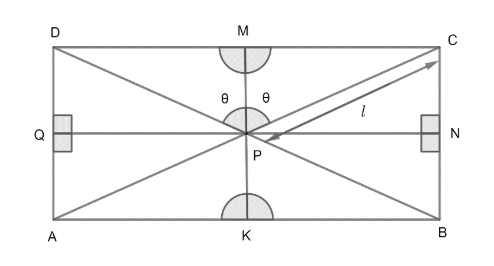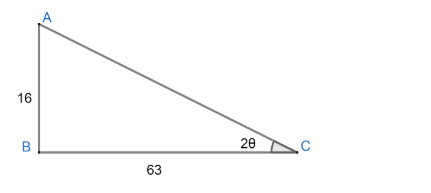Question
Question: Equations of the diagonals of a rectangle are \(y+8x-17=0\) and \(y-8x+7=0\). If the area of the rec...
Equations of the diagonals of a rectangle are y+8x−17=0 and y−8x+7=0. If the area of the rectangle is 8 sq. units, then the equation of the sides of the rectangle is/are
A) x = 1
B) x + y = 1
C) y = 9
D) x – 2y = 3
Solution
Hint: Find equation of bisectors of diagonals of the rectangle. Find angle between both the lines (diagonals) by using relation tanθ=1+m1m2m1−m2where m1&m2 are slopes of lines.
Here equations of both the diagonals of rectangle are
y+8x−17=0............................(1)
y−8x+7=0...........................(2)
We have to determine the sides of the rectangle if the area of the rectangle is 8. So, let us draw rectangle ABCD with bisectors of diagonals as below;

As, by the symmetry ∠DPM=CPM&∠CPN=∠BPN and area of all four triangles
ΔPCB=ΔPBA=ΔPAD=ΔDPCall will be equal.
We can prove the above relation as
area of ΔPCD=21×PM×CD=21×21KM×CD
Where KM = 2PM & KM = BC
Hence, area of ΔPCD=41BC.CD
Similarly, the area of all four triangles will be 41BC.CD.
Therefore area of ΔDPC=41.area of rectangle
As, we have area of rectangle as 8;
So, Area of ΔDPC=2
Let us suppose ∠DPM=∠MPC=θ and CP=′ℓ′.
Hence, from ΔMPC, we can write
sinθ=PCMC or MC=ℓsinθand cosθ=CPMP or MP=ℓcosθ
Therefore,
area of ΔPCD=21×CD×MP=21×2MC×MP=ℓsinθ.ℓcosθ=ℓ2sinθcosθ
As, we already have area of ΔDPC=2, Hence we get;
ℓ2sinθcosθ=2..............(3)
Now, we know the equation of diagonals as well. As angles between them is 2θ, hence, we can use the relation
tanθ=1+m1m2m1−m2between two lines, where θ is angle between them and m1 and m2are slopes of them.
As, here angle is 2θbetween two diagonals, and slopes can be determined by equations (1) and (2), so,
m1=−8,m2=8
Therefore,
tan2θ=1+(−8)(8)−8−8=6316
Now, we can draw a triangle as

Where AC=AB2+BC2 by Pythagoras theorem,
AC=162+632AC=256+3969AC=4225AC=65
Hence, from the given triangle, we get
cos2θ=6563,sin2θ=6516........................(4)
Now, from equation (3), we have
ℓ2sinθcosθ=2
Multiplying both sides by 2, we get
ℓ2(2sinθcosθ)=4
We know that sin2θ=2sinθcosθ, hence above equation can be written as;
ℓ2sin2θ=4
From equation (4), we have ,
sin2θ=6516,henceℓ2×6516=4ℓ2=465 or ℓ=265.................(5)
Now, we can calculate length PM and PN from ΔPMC.
As,
MC=ℓsinθPM=ℓcosθ
Now, we have cos2θ&sin2θ from equation (4), Hence, we need to convert sinθ&cosθ in following way;
We know a trigonometric identity as;
cos2θ=2cos2θ−1=1−2sin2θ
Hence, we can rewrite the above identity as
cos2θ=21+cos2θ,sin2θ=21−cos2θOrcosθ=21+cos2θ,sinθ=21−cos2θ
Now, we can get MC and PM as
MC=ℓ21−cos2θandPM=ℓ21+cos2θ
We know cos2θ=6563 from equation (4),
Hence,
MC=ℓ21−6563=ℓ652×21MC=65ℓandPM=ℓ21+6563=ℓ65128×21PM=ℓ6564=658ℓ
Now, we have already calculated the value of ℓ, from equation (5). Hence,
PM=658×265=4MC=651×265=21
Therefore,
PM=4 and MC=21...................(6)
Now, we know that if two linesax+by+c=0 and a1x+b1y+c1=0 are given, then their bisector are given by relation;
a2+b2ax+by+c=±a12+b12a1x+b1y+c1..........(7)
Now, from the given rectangle ABCD, MK and NQ are the bisector of diagonals BD and AC. Hence, we can write equation of MK and NQ by using equation (7) as;
We have diagonals BD and AC from equation (1) and (2) be
y+8x−17=0 and y−8x+7=0or8x+y−17=0 and 8x−y−7=0
Hence, using equation (7) we get equations of bisectors as;
12+828x+y−17=±12+828x−y−7Or8x+y−17=±(8x−y−7)
Case 1: Taking ‘+’ sign from another side of equal to, we get
8x+y−17=8x−y−72y=10y=5..............(8)
Case 2: Taking ‘-’ sign from another side of equals to , we get,
